ING分词
动词分词变化规则

动词分词变化规则动词分词有两种形式:现在分词(-ing)和过去分词(-ed)。
它们的变化规则如下:现在分词:- 一般情况下,在动词原形后面加上 -ing。
例如:walk → walking,eat → eating,talk → talking- 以不发音辅音字母 + y 结尾的动词,先将 y 变成 i 再加 -ing。
例如:carry → carrying,study → studying,fly → flying- 以“辅音字母 + 元音字母 + 辅音字母”结尾的动词,双写结尾的辅音字母再加 -ing。
例如:stop → stopping,commit → committing,forget → forgetting- 有些动词形式会改变,变化规则不一定相同,如:begin → beginning,go → going,lie → lying,see → seeing过去分词:- 一般情况下,在动词原形后面加上 -ed。
例如:talk → talked,listen → listened,play → played- 以不发音辅音字母 + y 结尾的动词,先将 y 变成 i 再加 -ed。
例如:carry → carried,study → studied,fly → flown- 以“辅音字母 + 元音字母 + 辅音字母”结尾的动词,双写结尾的辅音字母再加 -ed。
例如:stop → stopped,commit → committed,forget → forgotten- 有些动词的过去分词形式与原形相同,如:bet → bet,cut → cut,put → put。
动词ing形式变化规则表格
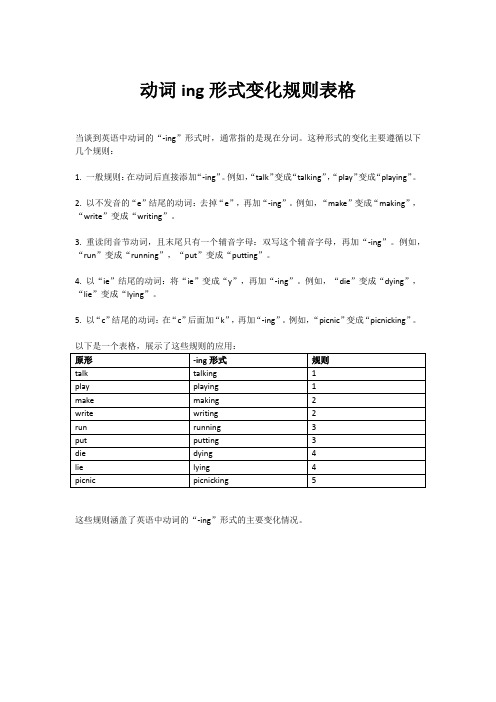
动词ing形式变化规则表格
当谈到英语中动词的“-ing”形式时,通常指的是现在分词。
这种形式的变化主要遵循以下几个规则:
1. 一般规则:在动词后直接添加“-ing”。
例如,“talk”变成“talking”,“play”变成“playing”。
2. 以不发音的“e”结尾的动词:去掉“e”,再加“-ing”。
例如,“make”变成“making”,“write”变成“writing”。
3. 重读闭音节动词,且末尾只有一个辅音字母:双写这个辅音字母,再加“-ing”。
例如,“run”变成“running”,“put”变成“putting”。
4. 以“ie”结尾的动词:将“ie”变成“y”,再加“-ing”。
例如,“die”变成“dying”,“lie”变成“lying”。
5. 以“c”结尾的动词:在“c”后面加“k”,再加“-ing”。
例如,“picnic”变成“picnicking”。
以下是一个表格,展示了这些规则的应用:
这些规则涵盖了英语中动词的“-ing”形式的主要变化情况。
ing分词的用法

ing分词的用法现在-ing分词的使用 1、在进行时态中应用-ing形式。
如: He is watching TV in the room. They were dancing at nine o'clock last night. 2、在there be结构中应用-ing形式。
如: There is a boy swimming in the river. 3、在have fun/problems结构中应用-ing 形式。
如: We have fun learning English this term. They had problems getting to the top of the mountain. 4、在介词后面应用-ing形式。
如: Thanks for helping me. Are you good at playing basketball? 5、在以下结构中应用-ing形式: enjoy doing sth 乐于做某事 finish doing sth 完成做某事 feel like doing sth 想要做某事 stop doing sth停止做某事 forget doing sth忘记做过某事 go on doing sth 继续做某事 remember doing sth 记得做过某事 like doing sth 喜欢做某事 keep sb doing sth 使某人一直做某事find sb doing sth 发现某人做某事see/hear/watch sb doing sth6、看到/听到/观看某人做某事,应用-ing形式。
try doing sth 试图做某事need doing sth 需要做某事prefer doing sth 宁愿做某事mind doing sth介意做某事miss doing sth错过做某事practice doing sth 练习做某事be busy doing sth 忙于做某事can't help doing sth 禁不住做某事索罗学院现在分词的用法详解现在分词(Present Participle)(又称-ing形式、现在进行式) ,是分词的一种,分词又分为现在分词和过去分词,它们都是非限定动词,即在句子里面不能单独充当谓语,但能充当其它的一些成分(定语,表语,补语和状语),并且它们具有动词的性质,所以又是类动词的一种。
ing分词

5、-ing形式作宾补
主语 + 谓语 + 宾语 + -ing宾补
• I heard a woman crying downstairs. • She is listening to her sister singing.
-ing形式作宾补:注意事项
感官动词之后,往往既可接ing形式作宾补,也可接不带to的不 定式作宾补。 • 接ing形式作宾补,表示动作正在进行。感觉到的动作不是 全过程。 • 接不带to的不定式,表示已经完成的动作,即感觉的动作是 全过程。 • • • • I saw him falling down from the bike. 我看到他正从自行车上摔下来。 I saw him fall down from the bike. 我看到他从自行车上摔下来了。
• I regret telling you he has gone away. • I regret to tell you he has gone away.(I am sorry to tell…)
mean +宾语
mean to do 打算、想 mean doing 意味着 I mean to go, but my father would not allow me to. 我想去,可是我爸爸不会同意我去。 To raise wage means increasing purchasing power. 涨工资意味着购买能力的提高。
-ing形式的时态(2)
完成式: -ing形式完成式表示的动作在谓语动词的动作
之前: Having dressed myself, I went to the office. 我穿好了衣服
就到办公室去。(-ing形式的动作在先)
ing分词的用法
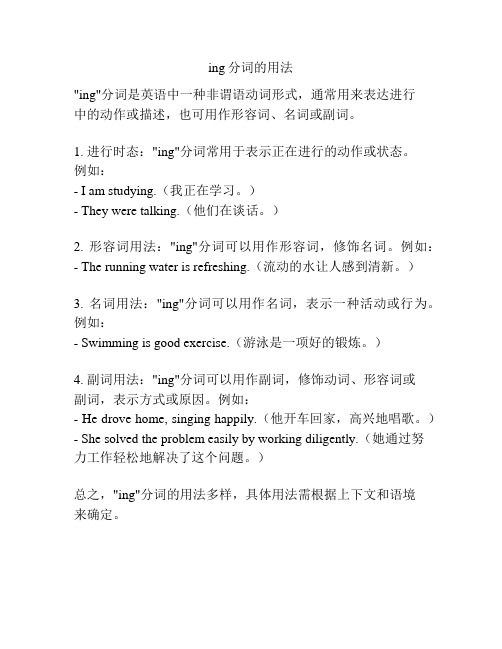
ing分词的用法
"ing"分词是英语中一种非谓语动词形式,通常用来表达进行
中的动作或描述,也可用作形容词、名词或副词。
1. 进行时态:"ing"分词常用于表示正在进行的动作或状态。
例如:
- I am studying.(我正在学习。
)
- They were talking.(他们在谈话。
)
2. 形容词用法:"ing"分词可以用作形容词,修饰名词。
例如:- The running water is refreshing.(流动的水让人感到清新。
)
3. 名词用法:"ing"分词可以用作名词,表示一种活动或行为。
例如:
- Swimming is good exercise.(游泳是一项好的锻炼。
)
4. 副词用法:"ing"分词可以用作副词,修饰动词、形容词或
副词,表示方式或原因。
例如:
- He drove home, singing happily.(他开车回家,高兴地唱歌。
)- She solved the problem easily by working diligently.(她通过努
力工作轻松地解决了这个问题。
)
总之,"ing"分词的用法多样,具体用法需根据上下文和语境
来确定。
ing分词作状语用法
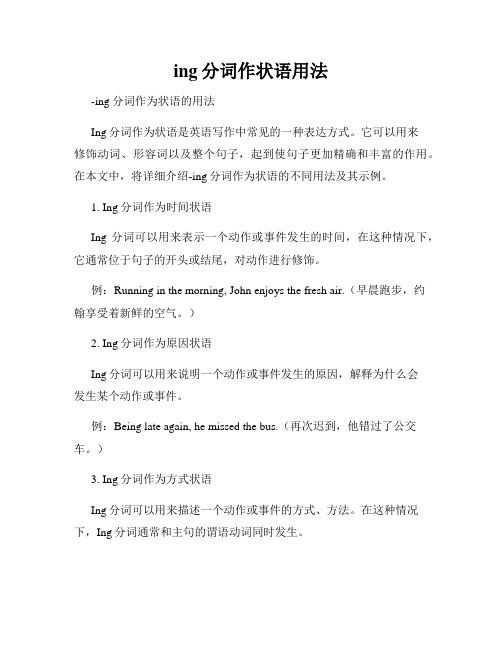
ing分词作状语用法-ing分词作为状语的用法Ing分词作为状语是英语写作中常见的一种表达方式。
它可以用来修饰动词、形容词以及整个句子,起到使句子更加精确和丰富的作用。
在本文中,将详细介绍-ing分词作为状语的不同用法及其示例。
1. Ing分词作为时间状语Ing分词可以用来表示一个动作或事件发生的时间,在这种情况下,它通常位于句子的开头或结尾,对动作进行修饰。
例:Running in the morning, John enjoys the fresh air.(早晨跑步,约翰享受着新鲜的空气。
)2. Ing分词作为原因状语Ing分词可以用来说明一个动作或事件发生的原因,解释为什么会发生某个动作或事件。
例:Being late again, he missed the bus.(再次迟到,他错过了公交车。
)3. Ing分词作为方式状语Ing分词可以用来描述一个动作或事件的方式、方法。
在这种情况下,Ing分词通常和主句的谓语动词同时发生。
例:She won the match by playing strategically.(她通过策略性地比赛获胜。
)4. Ing分词作为条件状语Ing分词可以用来表示一个动作或事件发生的前提条件,在这种情况下,Ing分词常常和主句之间存在因果关系。
例:Studying hard, you will pass the exam.(努力学习,你将通过考试。
)注意:Ing分词作为条件状语时,假设句子已经有一个明确的主语。
如果没有明确的主语,可以使用带有to的不定式作为替代。
例:To study hard is the key to passing the exam.(努力学习是通过考试的关键。
)5. Ing分词作为结果状语Ing分词可以用来表示一个动作或事件发生的结果,在这种情况下,Ing分词与句子的主语之间有着因果关系。
例:The storm caused flooding, leaving many people homeless.(暴风雨导致洪水,使许多人无家可归。
使用-ing分词的几种情况
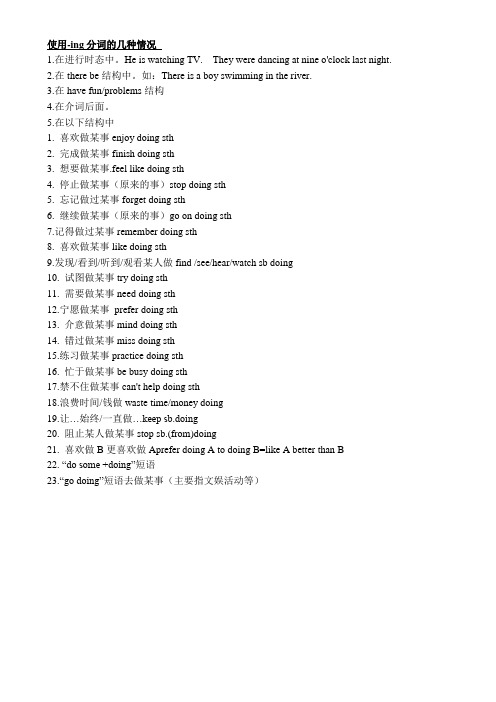
使用-ing分词的几种情况1.在进行时态中。
He is watching TV. They were dancing at nine o'clock last night.2.在there be结构中。
如:There is a boy swimming in the river.3.在have fun/problems结构4.在介词后面。
5.在以下结构中1. 喜欢做某事enjoy doing sth2. 完成做某事finish doing sth3. 想要做某事.feel like doing sth4. 停止做某事(原来的事)stop doing sth5. 忘记做过某事forget doing sth6. 继续做某事(原来的事)go on doing sth7.记得做过某事remember doing sth8. 喜欢做某事like doing sth9.发现/看到/听到/观看某人做find /see/hear/watch sb doing10. 试图做某事try doing sth11. 需要做某事need doing sth12.宁愿做某事prefer doing sth13. 介意做某事mind doing sth14. 错过做某事miss doing sth15.练习做某事practice doing sth16. 忙于做某事be busy doing sth17.禁不住做某事can't help doing sth18.浪费时间/钱做waste time/money doing19.让…始终/一直做…keep sb.doing20. 阻止某人做某事stop sb.(from)doing21. 喜欢做B更喜欢做Aprefer doing A to doing B=like A better than B22. “do some +doing”短语23.“go doing”短语去做某事(主要指文娱活动等)。
-ing分词的用法

-ing分词的用法篇一:八年级上册英语语法《现在-ing分词的使用》知识点整理现在-ing分词的使用1、在进行时态中应用-ing形式。
如:He is watching TV in the room. They were dancing at nine o'clock last night. 2、在there be结构中应用-ing形式。
如:There is a boy swimming in the river. 3、在have fun/problems结构中应用-ing形式。
如:We have fun learning English this term. They had problems getting to the top of the mountain. 4、在介词后面应用-ing形式。
如:Thanks for helping me. Are you good at playing basketball?5、在以下结构中应用-ing形式:enjoy doing sth 乐于做某事finish doing sth 完成做某事feel like doing sth 想要做某事stop doing sth停止做某事forget doing sth忘记做过某事go on doing sth 继续做某事remember doing sth 记得做过某事like doing sth 喜欢做某事keep sb doing sth 使某人一直做某事find sb doing sth 发现某人做某事see/hear/watch sb doing sth6、看到/听到/观看某人做某事,应用-ing形式。
try doing sth 试图做某事need doing sth 需要做某事prefer doing sth 宁愿做某事mind doing sth介意做某事miss doing sth错过做某事practice doing sth 练习做某事be busy doing sth 忙于做某事can't help doing sth 禁不住做某事本文由索罗学院整理篇二:现在分词的用法详解现在分词的用法详解现在分词(Present Participle)(又称-ing形式、现在进行式) ,是分词的一种,分词又分为现在分词和过去分词,它们都是非限定动词,即在句子里面不能单独充当谓语,但能充当其它的一些成分(定语,表语,补语和状语),并且它们具有动词的性质,所以又是类动词的一种。
-ing分词的短语及体貌
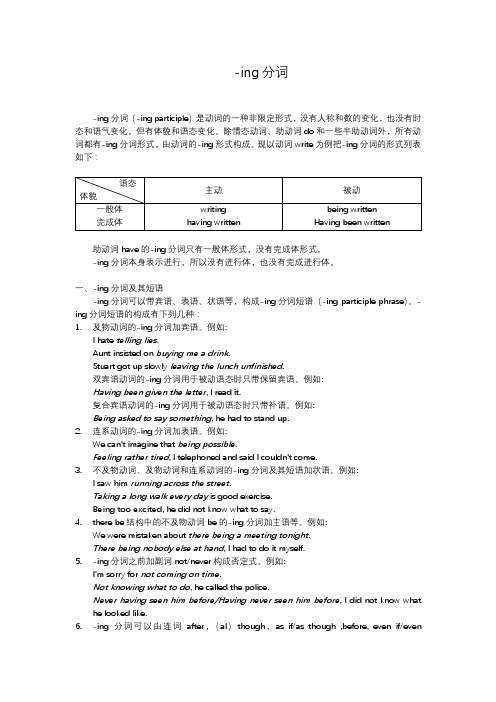
-ing分词-ing分词(-ingparticiple)是动词的一种非限定形式,没有人称和数的变化,也没有时态和语气变化,但有体貌和语态变化。
除情态动词、助动词do和一些半助动词外,所有动词都有-ing分词形式,由动词的-ing形式构成。
现以动词write为例把-ing分词的形式列表如下:助动词have的-ing分词只有一般体形式,没有完成体形式。
-ing分词本身表示进行,所以没有进行体,也没有完成进行体。
一、-ing分词及其短语-ing分词可以带宾语、表语、状语等,构成-ing分词短语(-ingparticiplephrase)。
-ing 分词短语的构成有下列几种:1.及物动词的-ing分词加宾语。
例如:I hate telling lies.Aunt insisted on buying me a drink.Stuart got up slowly leaving the lunch unfinished.双宾语动词的-ing分词用于被动语态时只带保留宾语。
例如:Having been given the letter, I read it.复合宾语动词的-ing分词用于被动语态时只带补语。
例如:Being asked to say something, he had to stand up.2.连系动词的-ing分词加表语。
例如:We can’t imagine that being possible.Feeling rather tired, I telephoned and said I couldn’t come.3.不及物动词、及物动词和连系动词的-ing分词及其短语加状语。
例如:I saw him running across the street.Taking a long walk every day is good exercise.Being too excited, he did not know what to say.4.there be结构中的不及物动词be的-ing分词加主语等。
ing分词作主语例句

ing分词作主语例句ing分词就是现在分词,是分词的一种。
现在分词在英语这一科目中,也是比较重要的一部分。
下面是为你整理的ing分词作主语的例句,希望大家喜欢!ing分词作主语的例句作主语:通常被看作是单数不可数名词,所以谓语动词用第三人称单数形式.Driving fast is very dangerous.Swimming is my favourite sport.Painting is an art.Hearing the bad news made him cry.注意:现在分词作主语时,和动词不定式一样,当它是较长的短语时,常常用it作形式主语,而把现在分词放到句末.如:It's nice spending the holiday at the beach.It's tiring working late.现在分词作主语时的常用句型a waste of timeno good/no useIt +be+ little/hardly any use + V-ing分词not/hardly worthworth/worthwhile如:It's no use complaining.It's no good smoking a lot.It's a waste of time doing such a thing.nono sense in(没有道理)There +be+ no point in(毫无意义) +V-ing分词no use inNothing worse than(没有比...更糟糕的)如:There was no knowing what he was doing.There is no point (in) doing so.这么做,毫无意义.经常跟在it +be后面的形容词,然后接动名词作实际主语的形容词还有:Odd古怪的\x09Crazy疯狂的\x09Hopeless无望的\x09Nice Funny好笑的\x09Foolish愚蠢的\x09interesting\x09Tiring 累人的better\x09terrible\x09Enjoyable愉快的\x09Pointless无意义的不定式作主语和现在分词作主语的区别作主语时:不定式:强调具体的、一次性的动作如:to learn an art is very hard.学习一门艺术很困难.现在分词:强调多次的、抽象的动作如:working in these conditions is not a pleasure.在这种条件下工作一点也不愉快.两种动词形式作主语时多用于it作形式主语的句型中.如:it ishard to learn an art.。
(完整版)ing分词用法归纳

-ing 分词用法概括1. -ing 分词概括-ing 分词的基本形式是由动词加-ing 组成,与动词的此刻分词形式一致。
-ing 分词的主要变化形式有一般式和达成式;一般式和达成式中又分别有主动形式及被动形式。
详见下表:主动形式被动形式一般式doing being done达成式having done having been done2.-ing 分词的意义(1)-ing 分词所表示的动作常与谓语动词的动作同时发生。
如:He used to stand there thinking. 他过去常站在那边思虑。
They held activities celebrating their culture.他们举行活动来庆贺他们的文化。
(2)-ing 分词若在 suggest, insist 等动词后或作结果状语时,表示的动作常发生在谓语动词的动作以后;He suggested us practicing English every day. 他建议我们每日练习英语。
He insists on going with us together.他坚持要跟我们一同去。
Her mother went away alone, leaving her crying there. 她母亲一个人走了,让她一个人在那边哭。
(3)-ing 分词若在 forget, regret, remember 等动词后或作时间状语时,表示的动作发生在谓语动词动作以前。
如:Can you still remember living there?你还可以记得在那边的生活状况吗?I don ’ t regret helping him, though he is unkind to us尽.管他对我们不友善,我对帮助他仍是不懊悔。
(4) -ing 分词若在介词before, after 以后,动作的先后依介词before, after 的意义而定。
ing分词作主语例句
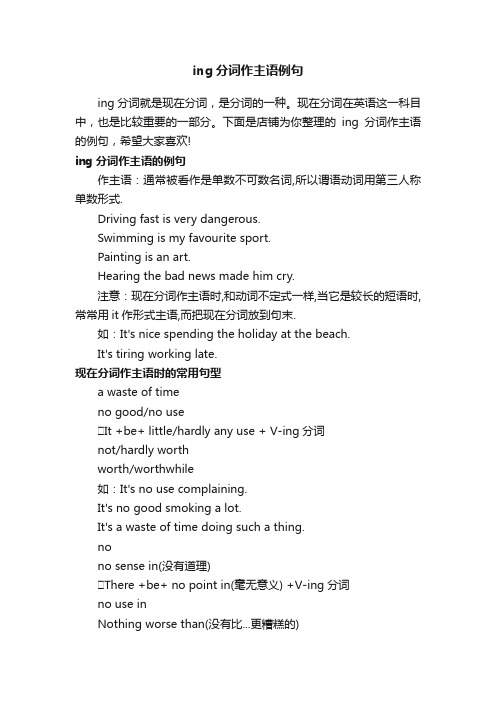
ing分词作主语例句ing分词就是现在分词,是分词的一种。
现在分词在英语这一科目中,也是比较重要的一部分。
下面是店铺为你整理的ing分词作主语的例句,希望大家喜欢!ing分词作主语的例句作主语:通常被看作是单数不可数名词,所以谓语动词用第三人称单数形式.Driving fast is very dangerous.Swimming is my favourite sport.Painting is an art.Hearing the bad news made him cry.注意:现在分词作主语时,和动词不定式一样,当它是较长的短语时,常常用it作形式主语,而把现在分词放到句末.如:It's nice spending the holiday at the beach.It's tiring working late.现在分词作主语时的常用句型a waste of timeno good/no useIt +be+ little/hardly any use + V-ing分词not/hardly worthworth/worthwhile如:It's no use complaining.It's no good smoking a lot.It's a waste of time doing such a thing.nono sense in(没有道理)There +be+ no point in(毫无意义) +V-ing分词no use inNothing worse than(没有比...更糟糕的)如:There was no knowing what he was doing.There is no point (in) doing so.这么做,毫无意义.经常跟在it +be后面的形容词,然后接动名词作实际主语的形容词还有:Odd古怪的\x09Crazy疯狂的\x09Hopeless无望的\x09NiceFunny好笑的\x09Foolish愚蠢的\x09interesting\x09Tiring累人的better\x09terrible\x09Enjoyable愉快的\x09Pointless无意义的不定式作主语和现在分词作主语的区别作主语时:不定式:强调具体的、一次性的动作如:to learn an art is very hard.学习一门艺术很困难.现在分词:强调多次的、抽象的动作如:working in these conditions is not a pleasure.在这种条件下工作一点也不愉快.两种动词形式作主语时多用于it作形式主语的句型中.如:it is hard to learn an art.ing分词作主语例句 ing分词就是现在分词,是分词的一种。
ing分词做状语
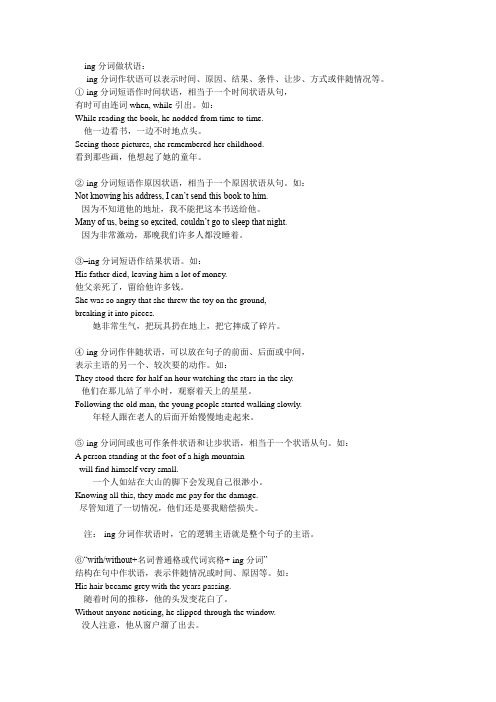
-ing分词作状语可以表示时间、原因、结果、条件、让步、方式或伴随情况等。
①-ing分词短语作时间状语,相当于一个时间状语从句,有时可由连词when, while引出。
如:While reading the book, he nodded from time to time.他一边看书,一边不时地点头。
Seeing those pictures, she remembered her childhood.看到那些画,他想起了她的童年。
②-ing分词短语作原因状语,相当于一个原因状语从句。
如:Not knowing his address, I can’t send this book to him.因为不知道他的地址,我不能把这本书送给他。
Many of us, being so excited, couldn’t go to sleep that night.因为非常激动,那晚我们许多人都没睡着。
③–ing分词短语作结果状语。
如:His father died, leaving him a lot of money.他父亲死了,留给他许多钱。
She was so angry that she threw the toy on the ground,breaking it into pieces.她非常生气,把玩具扔在地上,把它摔成了碎片。
④-ing分词作伴随状语,可以放在句子的前面、后面或中间,表示主语的另一个、较次要的动作。
如:They stood there for half an hour watching the stars in the sky.他们在那儿站了半小时,观察着天上的星星。
Following the old man, the young people started walking slowly.年轻人跟在老人的后面开始慢慢地走起来。
⑤-ing分词间或也可作条件状语和让步状语,相当于一个状语从句。
非谓语动词(一)- ing分词

非谓语动词(一)- ing分词1. -ing分词的构成-ing分词是由动词原形加词尾-ing构成。
-ing分词同样有时态和语态的变化,通常有下表几种形式(以do为例):-ing分词的否定形式是由not 加-ing分词构成。
●Not knowing his address, I could do nothing but stay at home and wait.不知道他的地址,我只好在家里等着。
●His not coming made all of us angry. 他没来使我们大家都很生气。
(1) -ing分词的一般式和完成式:-ing分词的一般式表示和谓语动词所表示的动作同时进行的动作;完成式表示在谓语动词所表示的动作之前发生的动作。
●Being a student, he was interested in books. 作为一个学生,他对书本很感兴趣。
●Not having studied his lessons very hard, he failed the examinations. 因为没有努力学习功课,他考试不及格。
(2) -ing分词的被动式:-ing分词的被动式表示它的逻辑主语是-ing分词动作的承受者。
根据-ing分词动作发生的时间,-ing分词的被动式有一般被动式(being done)和完成被动式(having been done)。
●The question being discussed is very important. 正在被讨论的问题很重要。
●He never talked about his having been interviewed by the reporter. 他从来没谈起过他被记者采访的事情。
●Having been criticized by the teacher, he gave up smoking. 被老师批评以后,他把烟戒了。
ing分词做状语的句子
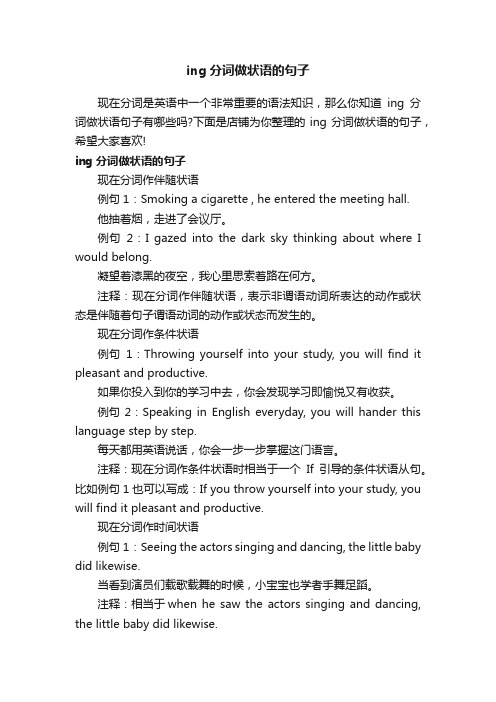
ing分词做状语的句子现在分词是英语中一个非常重要的语法知识,那么你知道ing分词做状语句子有哪些吗?下面是店铺为你整理的ing分词做状语的句子,希望大家喜欢!ing分词做状语的句子现在分词作伴随状语例句1:Smoking a cigarette , he entered the meeting hall.他抽着烟,走进了会议厅。
例句2:I gazed into the dark sky thinking about where I would belong.凝望着漆黑的夜空,我心里思索着路在何方。
注释:现在分词作伴随状语,表示非谓语动词所表达的动作或状态是伴随着句子谓语动词的动作或状态而发生的。
现在分词作条件状语例句1:Throwing yourself into your study, you will find it pleasant and productive.如果你投入到你的学习中去,你会发现学习即愉悦又有收获。
例句2:Speaking in English everyday, you will hander this language step by step.每天都用英语说话,你会一步一步掌握这门语言。
注释:现在分词作条件状语时相当于一个If引导的条件状语从句。
比如例句1也可以写成:If you throw yourself into your study, you will find it pleasant and productive.现在分词作时间状语例句1:Seeing the actors singing and dancing, the little baby did likewise.当看到演员们载歌载舞的时候,小宝宝也学者手舞足蹈。
注释:相当于when he saw the actors singing and dancing, the little baby did likewise.例句2:Having finished reading passage one, we then moved on to the second passage.完成第一章之后,我们进而进入第二章。
加ing的规则

加ing的规则添加-ing是英语动词的一种常见形式变化,它可以用来表示正在进行的动作或者作为动词的现在分词形式。
英语中,在动词的词尾加-ing的规则并不复杂,但有一些例外情况需要注意。
下面将详细介绍加-ing的规则。
一般规则:1. 对于大多数动词,只需在词尾加-ing,例如:walk(走)→ walking(走着)、run(跑)→ running(跑着)。
2. 对于以不发音的“e”结尾的动词,需要去掉“e”,然后再加上-ing,例如:write(写)→ writing(写着)、take (带走)→ taking(带走着)。
3. 对于以一个辅音字母结尾的重读闭音节时,需要双写这个辅音字母,再加上-ing,例如:stop(停止)→ stopping (停止着)、swim(游泳)→ swimming(游泳着)。
4. 对于以“ie”结尾的动词,通常需要将“ie”变成“y”,然后再加上-ing,例如:lie(躺)→ lying(躺着)、die (死)→ dying(死着)。
特殊情况:1. 对于以“c”结尾的动词,如果接下来是一个重音音节,需要将“c”变成“ck”,然后再加上-ing,例如:picnic(野餐)→ picnicking(野餐着)。
2. 对于以“ie”结尾的动词,如果接下来是一个“r”,则需要将“ie”变成“i”,再加上-ing,例如:brier(扫帚)→ briering(扫帚着)。
3. 对于以“ee”结尾的动词,需要将最后一个“e”去掉,再加上-ing,例如:see(看见)→ seeing(看见着)。
4. 有一些规则略微复杂,需要根据词尾字母和重音音节来判断,例如:begin(开始)→ beginning(开始着)、model (模型)→ mo deling(模型着)。
需要注意的是,加-ing的规则只是一般情况下的规则,并不适用于所有动词。
有些动词的形态变化要遵循特定的规则,因此还需要查找相关的参考资料。
- 1、下载文档前请自行甄别文档内容的完整性,平台不提供额外的编辑、内容补充、找答案等附加服务。
- 2、"仅部分预览"的文档,不可在线预览部分如存在完整性等问题,可反馈申请退款(可完整预览的文档不适用该条件!)。
- 3、如文档侵犯您的权益,请联系客服反馈,我们会尽快为您处理(人工客服工作时间:9:00-18:30)。
5.在encourage, permit, allow, recommend, advise, authorise等V之后,一般用-ing分 词结构作宾语,但也可带有自己的逻辑 主语的不定式结构。 eg. They encouraged learning English by radio and TV. They encouraged me to learn English by radio and TV.
regret. I regret telling you that Jhon stole it. (后悔做过/正在做sth.) I regret to tell you that Jhon stole it. (感觉遗憾/抱歉去做sth.)
在stop, leave off, go on等V之后,通常用ing分词结构作宾语;若用不定式结构, 便不是宾语而是目的状语,相当于in order to. eg. They stopped watching TV at 9:30. =At 9:30 they did not watch TV any more. They stopped to watch TV at 9:30. =They poused to at 9:30 in order to watch TV.
3.在try, mean, can't help等V之后用-ing分词 还是不定式,取决于这些V本身的不同含 义。 eg. Your plan would mean spending hours. (意味着。。) I didn't mean to make you angry. (打算。。。)
4.在agree, decide等V之后,可直接加不定 式,但若带-ing分词,则必须在-ing分词 前添加介词。 eg. to share They agreed the remuneration. on sharing
• V+宾语+from+-ing分词
常见的这些词有:stop, keep, prevent, hinder, restain, save,etc.
eg. We can't stop it (from) happening here.
注:在此句式中,如果是主动形式则from有 时可以省略;若为被动态,则from不可 省略。
现在分词做状语: 1.现在分词做状语,可以表示时间、原因、 条件、让步、连续等,相当于一个状语从句。 句子的主语是现在分词的发出者。 eg. Knowing what had happend, he apologized to me for his impoliteness. 2.分词动作和谓语动作完全同时发生时,可 用when/while 引到现在分词结构。 eg.Don't mention that while talking to her. 3.如果分词动作发生在谓语动作之前,分词 要用完成时。 eg.Having done their assignments, the students left the classroom.
2.-ing分词的逻辑主语已在句中其他地方出 现,因而也无需表示出来。 eg. Would you mind ringing me up to tomorrow.
3.-ing分词本身带有自己的主语,因而要表 现出来。如果不表示出来回产生歧义。 eg. She insisted on me going.
It begins to rain It begins rainning
有什么区别?
4.在attempt, intend, plan之后,既可跟不定 式又可以接-ing分词。(一般跟不定式) eg. I planned to go/going myself. 如果上述词为进行体,则只能跟不定式。 eg. We are planning to visit France this summer.
1.在begin, can't bear, cease, continue, dread, like, love, neglect, prefer, propose, start,etc.V之后,如表示一般的行为,用ing分词居多;如表示特定的或具体的动 作,则用不定式较多。 eg. I can't bear living alone. I can't bear to see the child treated stupidly.
动名词与现在分词
二者在形式上没有区别,都是以-ing结尾, 但在用法上有相同点也有不同点。
1.相同点 2.不同点
3.都能做状语: 动名词不可以单独做状语,一般 在其前面加上相应的介词或介词短语。 (about, after, against, apart from, at, before,besides, by, for, for fear, for the purpose of, instead of,with a view to, with the object to,etc.) eg.After finishing her homework ,the little girln began to do some cleaning.
eg.It can't be stopped from happening here.
既能直接带不定式又能直接 带-ing分词的V:
1.能带不定式和-ing分词而意义无甚区别 的V
2.能带不定式和-ing分词而意义不同的V
能带不定式和-ing分词而意义无甚区别的V: attempt, begin, can't bear, continue, deserve, dread, hate, intend, like, love, need, neglect, plan, prefer, start,etc.
return to page 2
1.V+宾语+into+-ing分词.
2.V+宾语+from+-ing分词. 3.V+宾语+for/on/of等+ing分词
常见的这些词有:trick, mislead, shame, surprise, talk, trape, beguile, deceive, fool,etc.
We plan to visit France this summer.
ห้องสมุดไป่ตู้
能带不定式和-ing分词而意义不同 的V
在forget, go on, leave off, mean, regret, remember, stop,etc.
这类动词又可以分为五类:
1.在remember, forget之后,用-ing分词表示 动作发生在“记得”、“忘记”之前, 用不定式则表示动作发生在“记得”、 “忘记”之后。 (记得、忘记做过sth.)(记得、忘记要做sth.) eg. Can't you remember telling me the story last night?=You told me the story last night. Can't you remember it? You must remember to tell him all that. =You must tell him all that.Don't forget it.
1.都能做表语: His job is washing,cleaning and taking care of the children.(动名词) The situation is encouraging.(令人鼓舞的) The man is very charming. 现在分词作表语多用来表示主语所具有 的特征,常用作标语的现在分词有: amusing, astonishing, charming, misleading,promising, shocking,etc.
2.在need, want, require, deserve,etc.V之后, 可用-ing分词的主动形式表被动意义,相 当于不定式的被动态。 eg. The house wants rewiring. The house wants to be rewired.
3.在begin, start之后,若跟的是静态动词, 便只能用不定式。 We began to to see what he meant. 注:当 begin, start已用于进行体时,其后 的V也用不定式。 It's beginning to rain
2.都能做定语: 动名词作定语一般放在名词或代词的 前面,表示所修饰名词的用途。 eg. a writing desk=a desk for writing 现在分词作定语的两种情况: 1.单个的现在分词常放在所修饰 名词的前面。 eg.The running dog chaced moth. 2.现在分词短语常放在所修饰名 词的后面做后置定语,相当于一个定语 从句。eg.A little child learning to walk often falls=…who is learning to …
4.现在分词做状语时,其动作必须是主句 中的主语发出的,否则不能成立。 eg.Seeing from the top of the mountain,we can find that the high buildings look like toys.(√) Seeing from the top of the mountain, the high buildings look like toys.(X)
1. He tricked her into marrying him by pretending that he was rich.(这个男的他。) 2. Her sudden question surprised him into betraying himself. 3.Bob talked us into walking home with him
